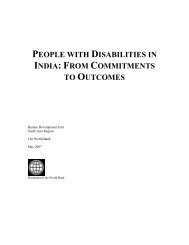FREE Download - TARSHI
FREE Download - TARSHI
FREE Download - TARSHI
Create successful ePaper yourself
Turn your PDF publications into a flip-book with our unique Google optimized e-Paper software.
trustworthiness of the translated version. Additionally, as most of the data collection has been done in<br />
the local language of the region, the material collected was translated into English before it could be<br />
coded and analysed. However, again, none of the studies mentions whether the responses were<br />
back-translated. Admittedly, this procedure is expensive, and its omission is not surprising in the light of<br />
scarce funding for sexuality research.<br />
Data collection: Very few studies have presented details of the procedures of data collection and<br />
analysis. Studies that do so include Abraham and Kumar's (1999) study on the sexual experiences of<br />
college students, Grenon's (1996) study on gender relations and illness management behaviour, Grenon<br />
and Mawji's (1996) study on perceptions of STDs, and Khanna et al's (1998) study on sexual coercion<br />
and reproductive health. Some of the good practices in the data collection procedures employed in<br />
these studies include:<br />
• careful selection and training of interviewers - awareness of gender issues, etc<br />
• obtaining informed consent for both interviews and recording<br />
• ensuring privacy and confidentiality<br />
• conducting repeat interviews with increasing sensitivity<br />
• ongoing analysis for further refinement of research questions/checklists<br />
• providing emotional support/counselling for the interviewers as well as the respondents<br />
• conducting review sessions<br />
Analysis: A few qualitative studies have identified and categorised emerging themes based on verbatim<br />
responses, and have developed case profiles from an emic (2) perspective (Chandiramani, 1998;<br />
Khanna, 2000; Sodhi, 2000). Including local terminology, expressions and verbatim quotes gives voice<br />
to the respondents and provides greater authenticity in qualitative studies. It also offsets the tendency<br />
to perpetuate stereotypes and conventional notions about gender, class and ethnic differences<br />
(Petchesky, 2000). The findings generated from some of the qualitative studies adequately reflect<br />
cultural sensitivity and richness. Those studies (Amin et al, 1996, 1997; Chandiramani, 1998; Grenon,<br />
1996; Khanna, 1998; Joshi, 1997; Sodhi, 2000; Verma, 2000) that have presented local terminologies<br />
and expressions as well as the verbatim responses of participants, have successfully illustrated the<br />
participants' socio-cultural perspectives on sexuality. Other studies (e.g. Amin et al, 1997) have<br />
analysed the emotional responses of the participants. Some of these qualitative studies have used<br />
computer packages such as Anthropac, DtSearch, and Ethnograph for text analysis, but none have<br />
indicated how these packages influenced the final analysis. Interpretative comments have largely<br />
disregarded the complexity of the issue or the context of the group being researched. A notable<br />
exception is George's (2000) study that provides a good contextual description. Most researchers rarely<br />
refer to contradictions or differences from other findings.<br />
Some of the researchers have revealed how the research context influences the responses of<br />
participants. They have highlighted how peer pressure has influenced the way interviewees responded<br />
in group situations as compared to individual interviews. These differences were often gendered. In the<br />
SARTHI study (Amin et al. 1997), boys tended to brag about their sexual experiences in groups, while<br />
they expressed fears and insecurities in private. In contrast, young women were more likely to express<br />
ignorance of sexual matters in groups, and proved more knowledgeable when interviewed individually<br />
(Ubale et al. 1996-97).<br />
The analysis in studies such as those by George (2000) and Maitra and Schensul (2000) reveal how<br />
respondents have different 'stories' to express multiple levels of understanding of their sexuality, rather<br />
than one story that is more true than any other.<br />
(2) Emic: Ethnographic research attempts to understand human beliefs and behaviour from the point of view of the people being studied. This is known as<br />
taking the emic or "insider" perspective (Gittelsohn et al. 1995).<br />
14










